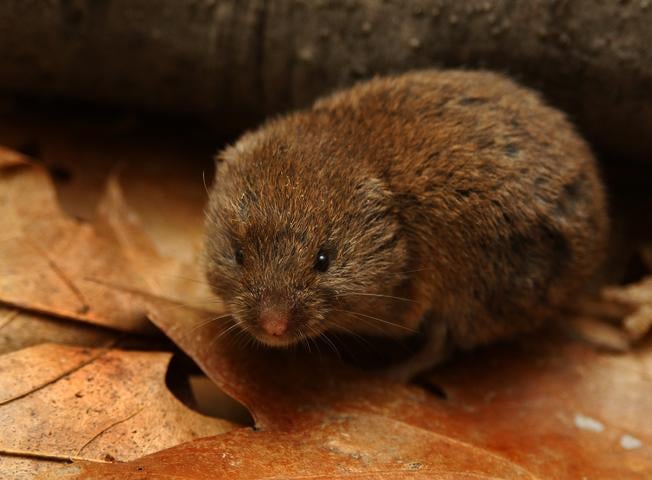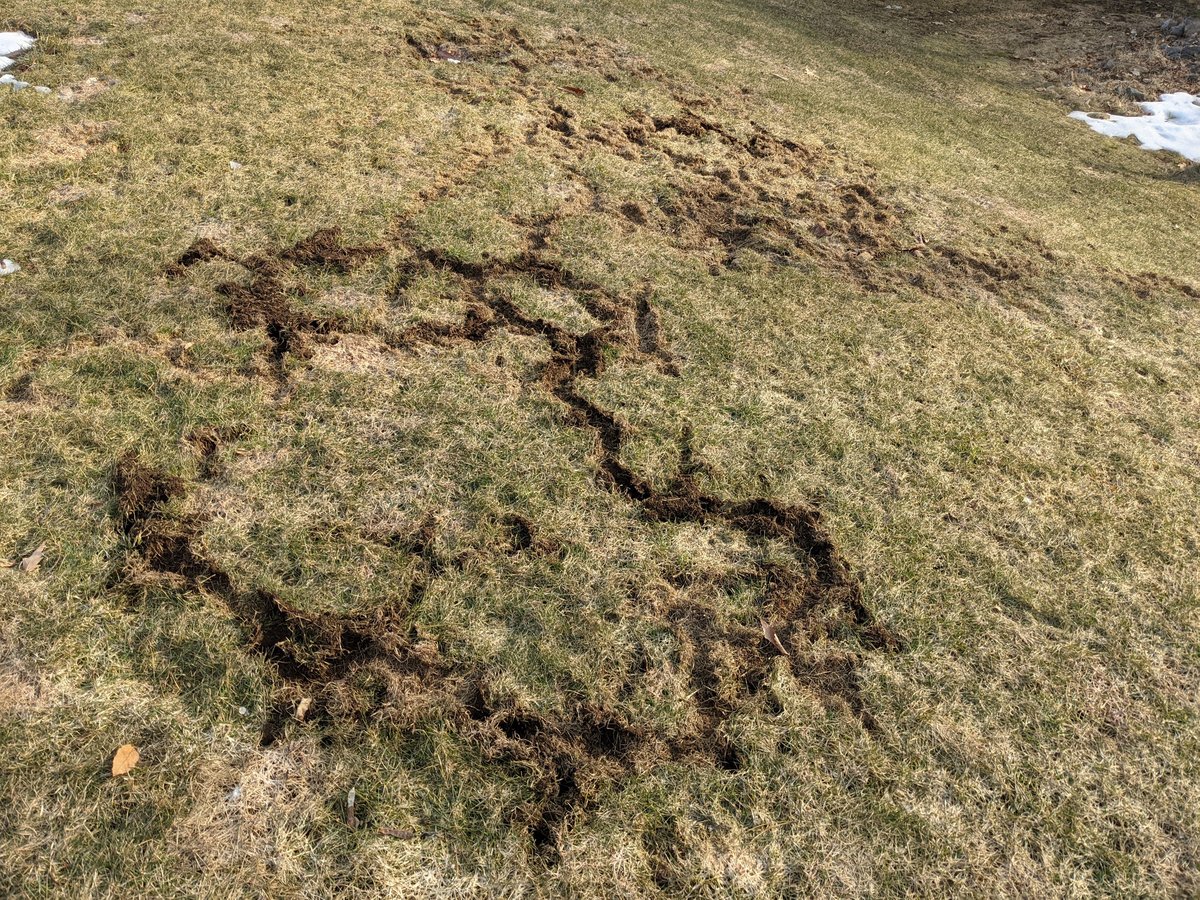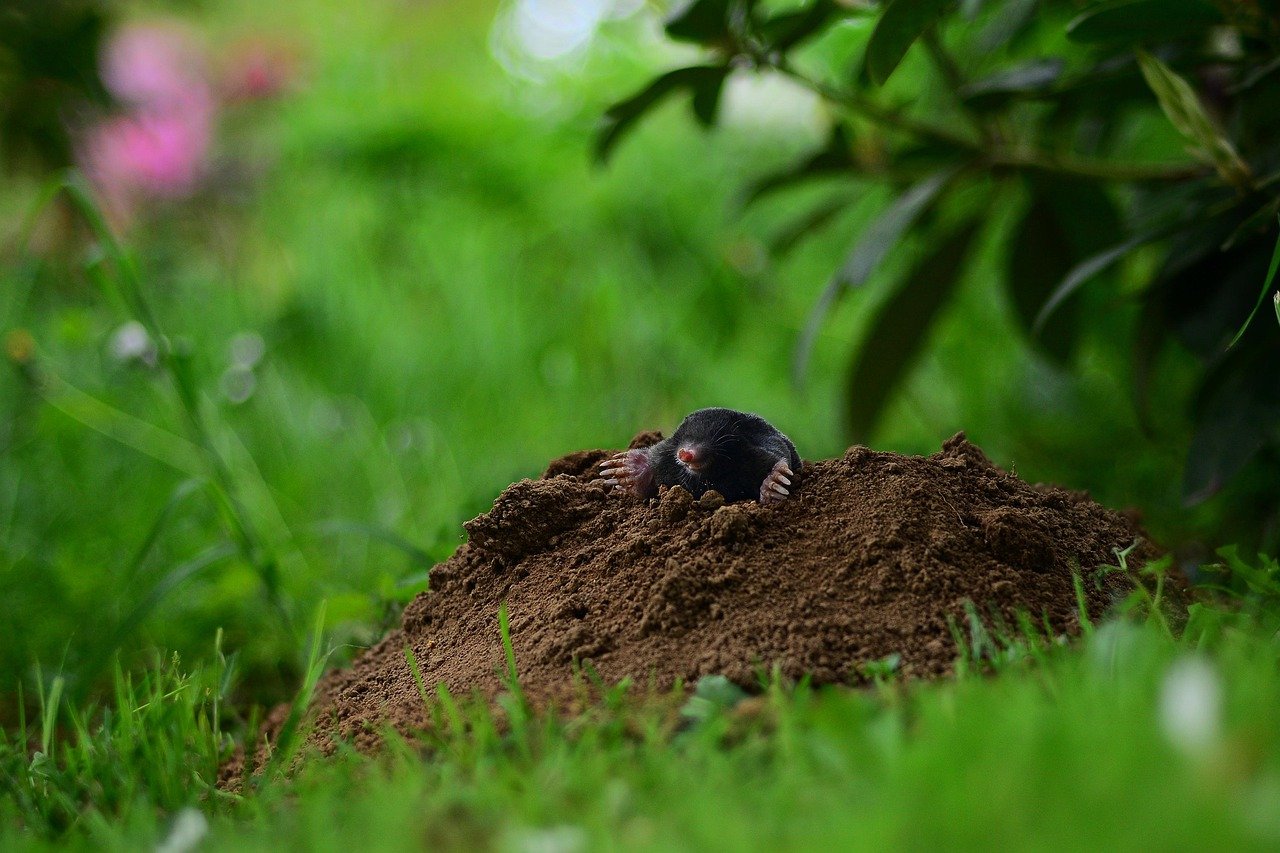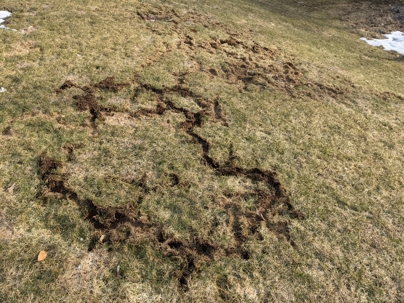Voles vs. Moles: How to Tell The Difference & How to Get Rid of Them
Voles. Moles. You may not think there’s any difference between them. In fact, they sound so similar, you might just think we’re starting to go into a children’s nursery rhyme. I am a mole and I live in a hole…
But even though these two lawn pests sound similar by name and can cause similar damage to your lawn and landscape, they are actually quite different.
Use This Pest Guide to Identify & Eliminate 28 Different Pests!
Let’s learn more about voles vs. moles and how you can identify them and properly kick them to the curb so they stop destroying your lovely lawn.
Voles or Moles
Just like peanut butter and jelly and stars and stripes, moles and voles always seem to go together.
In fact, the only similarities between these two critters is the rhyming of their names and the realization that they both dig underground. Oh, there’s one more thing they have in common: They can both drive you crazy with the stress they cause due to their incessant tunnel digging in your yard.
But don’t feel bad if you don’t know the differences between voles vs. moles. Many people incorrectly blame moles for vole damage and vice-versa.
Here is everything you need to know about each pest so you can distinguish one from the other and eliminate them from your lawn.
All About Voles
Let’s start with voles. They are compact little rodents with reddish brown or black fur; short, stocky bodies; short legs; and short tails.
 Voles are vegetarians. Think “V” is for vole and vegetarian to remember this one. This means they eat roots, bulbs, seeds, tree bark, and plant foliage. Because of their diet, they tend to enjoy flower beds and hang out under areas where you have bird feeders with seed.
Voles are vegetarians. Think “V” is for vole and vegetarian to remember this one. This means they eat roots, bulbs, seeds, tree bark, and plant foliage. Because of their diet, they tend to enjoy flower beds and hang out under areas where you have bird feeders with seed.
They are prolific reproducers who can produce 5 to 10 litters per year, each with an average of 5 babies. And they spend a good chunk of their lives underground eating your plant parts and pieces, which can damage the roots systems. Their tunnels aren’t raised and they have open entrance holes you can see in the dirt.
Voles typically tunnel on the surface creating two-inch wide runways with golf-ball-sized entry holes. Their surface tunnels are usually most noticeable in early spring. When doing your research on how to get rid of voles, there are EPA-approved rodenticides you can purchase to control them, but you must read the labels carefully and apply the products in specific protected bait stations to minimize hazards to other animal species. Also, only place bait stations at active vole entrance holes.
When doing your research on how to get rid of voles, there are EPA-approved rodenticides you can purchase to control them, but you must read the labels carefully and apply the products in specific protected bait stations to minimize hazards to other animal species. Also, only place bait stations at active vole entrance holes.
Other ways to prevent vole damage include removing excess mulch, thatch, weeds, and litter from your yard regularly, as well as encouraging natural predators like snakes and hawks.
Some repellents are also available that you can use to alter the taste of your plants and make eating them undesirable, such as those containing an ingredient called capsaicin (the same ingredient that makes chili peppers spicy).
All About Moles
Moles look different from voles in that they have pointed snouts, large paws for digging in your lawn, and nearly invisible eyes and ears.  Moles, unlike voles, are meat eaters. Like our vole trick, this time think “M” for moles and meat. This means they love food like earthworms, grubs, and insects.
Moles, unlike voles, are meat eaters. Like our vole trick, this time think “M” for moles and meat. This means they love food like earthworms, grubs, and insects.
Tunneling habits is another big differentiator between voles vs. moles. While voles have those open entranceways and make tunnels that aren’t raised, moles dig visibly raised tunnel ridges, leave mini volcano-shaped soil mounds, and create more of a closed tunnel system without visible entrance holes.  If you’re seeing tunneling in your lawn that looks like this description, you likely have moles. And if you think you see a lot of tunneling, you may even think there is a whole army of moles in your lawn. However, typically only two or three moles occupy the same tunnel system. But because moles eat between 70% to 100% of their weight in food each day, they have a large home range. Five moles per acre is usually what’s considered a large mole population.
If you’re seeing tunneling in your lawn that looks like this description, you likely have moles. And if you think you see a lot of tunneling, you may even think there is a whole army of moles in your lawn. However, typically only two or three moles occupy the same tunnel system. But because moles eat between 70% to 100% of their weight in food each day, they have a large home range. Five moles per acre is usually what’s considered a large mole population.
Moles are lonely creatures, living like hermits in their underground burrows. When the weather cools, they just retreat deeper into the soil.
If you’re looking for how to get rid of moles, this one is a little trickier. There are some products that contain castor oil that can deter moles and voles because they add a nasty smell the pests don’t like. These products come in both liquid and granular forms and can be found at home improvement stores.
Another Option For How to Get Rid of Moles: Grub Control
Since moles are meat eaters, their presence might also be a sign that you have grubs. Eliminating one of the main food sources of moles could also help deter them.
Natural Green Lawn & Pest would be happy to come inspect your lawn for grubs and offer treatment options.  While this will certainly take care of your grubs and may help limit your moles, it’s not a guaranteed way to completely eliminate moles. Moles may still be hanging around to enjoy those earthworms you’ve got available.
While this will certainly take care of your grubs and may help limit your moles, it’s not a guaranteed way to completely eliminate moles. Moles may still be hanging around to enjoy those earthworms you’ve got available.
However, sometimes people notice the combination of grub control and mole repellent work well to reduce mole damage.
Need Some Professional Help?
There you have it: The vole vs. mole debate solved! Now you can identify what’s messing with your lawn or your plants in Central and Southern Maryland and start eliminating these nuisance pests from your yard.
Still having trouble either figuring out what kind of critter you have on your property or keeping them away? We understand. Let Natural Green come check out your problem and help. We look at a lot of lawns all day and have dealt with many vole or mole problems. We can find out what the real problem is and offer some suggestions to help.
Want to get back to enjoy a lawn that is not full of tunnels and meat-eating moles? Hoping to save your plants from those veggie-eating voles? Give us a call and we’ll bring our proven lawn and pest control experience and create a custom plan for your Central and Southern Maryland home. Get started today with a free quote.
Voles. Moles. You may not think there’s any difference between them. In fact, they sound so similar, you might just think we’re starting to go into a children’s nursery rhyme. I am a mole and I live in a hole…
But even though these two lawn pests sound similar by name and can cause similar damage to your lawn and landscape, they are actually quite different.
Use This Pest Guide to Identify & Eliminate 28 Different Pests!
Let’s learn more about voles vs. moles and how you can identify them and properly kick them to the curb so they stop destroying your lovely lawn.
Voles or Moles
Just like peanut butter and jelly and stars and stripes, moles and voles always seem to go together.
In fact, the only similarities between these two critters is the rhyming of their names and the realization that they both dig underground. Oh, there’s one more thing they have in common: They can both drive you crazy with the stress they cause due to their incessant tunnel digging in your yard.
But don’t feel bad if you don’t know the differences between voles vs. moles. Many people incorrectly blame moles for vole damage and vice-versa.
Here is everything you need to know about each pest so you can distinguish one from the other and eliminate them from your lawn.
All About Voles
Let’s start with voles. They are compact little rodents with reddish brown or black fur; short, stocky bodies; short legs; and short tails.
 Voles are vegetarians. Think “V” is for vole and vegetarian to remember this one. This means they eat roots, bulbs, seeds, tree bark, and plant foliage. Because of their diet, they tend to enjoy flower beds and hang out under areas where you have bird feeders with seed.
Voles are vegetarians. Think “V” is for vole and vegetarian to remember this one. This means they eat roots, bulbs, seeds, tree bark, and plant foliage. Because of their diet, they tend to enjoy flower beds and hang out under areas where you have bird feeders with seed.
They are prolific reproducers who can produce 5 to 10 litters per year, each with an average of 5 babies. And they spend a good chunk of their lives underground eating your plant parts and pieces, which can damage the roots systems. Their tunnels aren’t raised and they have open entrance holes you can see in the dirt.
Voles typically tunnel on the surface creating two-inch wide runways with golf-ball-sized entry holes. Their surface tunnels are usually most noticeable in early spring. When doing your research on how to get rid of voles, there are EPA-approved rodenticides you can purchase to control them, but you must read the labels carefully and apply the products in specific protected bait stations to minimize hazards to other animal species. Also, only place bait stations at active vole entrance holes.
When doing your research on how to get rid of voles, there are EPA-approved rodenticides you can purchase to control them, but you must read the labels carefully and apply the products in specific protected bait stations to minimize hazards to other animal species. Also, only place bait stations at active vole entrance holes.
Other ways to prevent vole damage include removing excess mulch, thatch, weeds, and litter from your yard regularly, as well as encouraging natural predators like snakes and hawks.
Some repellents are also available that you can use to alter the taste of your plants and make eating them undesirable, such as those containing an ingredient called capsaicin (the same ingredient that makes chili peppers spicy).
All About Moles
Moles look different from voles in that they have pointed snouts, large paws for digging in your lawn, and nearly invisible eyes and ears.  Moles, unlike voles, are meat eaters. Like our vole trick, this time think “M” for moles and meat. This means they love food like earthworms, grubs, and insects.
Moles, unlike voles, are meat eaters. Like our vole trick, this time think “M” for moles and meat. This means they love food like earthworms, grubs, and insects.
Tunneling habits is another big differentiator between voles vs. moles. While voles have those open entranceways and make tunnels that aren’t raised, moles dig visibly raised tunnel ridges, leave mini volcano-shaped soil mounds, and create more of a closed tunnel system without visible entrance holes.  If you’re seeing tunneling in your lawn that looks like this description, you likely have moles. And if you think you see a lot of tunneling, you may even think there is a whole army of moles in your lawn. However, typically only two or three moles occupy the same tunnel system. But because moles eat between 70% to 100% of their weight in food each day, they have a large home range. Five moles per acre is usually what’s considered a large mole population.
If you’re seeing tunneling in your lawn that looks like this description, you likely have moles. And if you think you see a lot of tunneling, you may even think there is a whole army of moles in your lawn. However, typically only two or three moles occupy the same tunnel system. But because moles eat between 70% to 100% of their weight in food each day, they have a large home range. Five moles per acre is usually what’s considered a large mole population.
Moles are lonely creatures, living like hermits in their underground burrows. When the weather cools, they just retreat deeper into the soil.
If you’re looking for how to get rid of moles, this one is a little trickier. There are some products that contain castor oil that can deter moles and voles because they add a nasty smell the pests don’t like. These products come in both liquid and granular forms and can be found at home improvement stores.
Another Option For How to Get Rid of Moles: Grub Control
Since moles are meat eaters, their presence might also be a sign that you have grubs. Eliminating one of the main food sources of moles could also help deter them.
Natural Green Lawn & Pest would be happy to come inspect your lawn for grubs and offer treatment options.  While this will certainly take care of your grubs and may help limit your moles, it’s not a guaranteed way to completely eliminate moles. Moles may still be hanging around to enjoy those earthworms you’ve got available.
While this will certainly take care of your grubs and may help limit your moles, it’s not a guaranteed way to completely eliminate moles. Moles may still be hanging around to enjoy those earthworms you’ve got available.
However, sometimes people notice the combination of grub control and mole repellent work well to reduce mole damage.
Need Some Professional Help?
There you have it: The vole vs. mole debate solved! Now you can identify what’s messing with your lawn or your plants in Central and Southern Maryland and start eliminating these nuisance pests from your yard.
Still having trouble either figuring out what kind of critter you have on your property or keeping them away? We understand. Let Natural Green come check out your problem and help. We look at a lot of lawns all day and have dealt with many vole or mole problems. We can find out what the real problem is and offer some suggestions to help.
Want to get back to enjoy a lawn that is not full of tunnels and meat-eating moles? Hoping to save your plants from those veggie-eating voles? Give us a call and we’ll bring our proven lawn and pest control experience and create a custom plan for your Central and Southern Maryland home. Get started today with a free quote.
Image Source: Vole, Mole, Mole Hole
Share This
Voles. Moles. You may not think there’s any difference between them. In fact, they sound so similar, you might just think we’re starting to go into a children’s nursery rhyme. I am a mole and I live in a hole…
But even though these two lawn pests sound similar by name and can cause similar damage to your lawn and landscape, they are actually quite different.
Use This Pest Guide to Identify & Eliminate 28 Different Pests!
Let’s learn more about voles vs. moles and how you can identify them and properly kick them to the curb so they stop destroying your lovely lawn.
Voles or Moles
Just like peanut butter and jelly and stars and stripes, moles and voles always seem to go together.
In fact, the only similarities between these two critters is the rhyming of their names and the realization that they both dig underground. Oh, there’s one more thing they have in common: They can both drive you crazy with the stress they cause due to their incessant tunnel digging in your yard.
But don’t feel bad if you don’t know the differences between voles vs. moles. Many people incorrectly blame moles for vole damage and vice-versa.
Here is everything you need to know about each pest so you can distinguish one from the other and eliminate them from your lawn.
All About Voles
Let’s start with voles. They are compact little rodents with reddish brown or black fur; short, stocky bodies; short legs; and short tails.
 Voles are vegetarians. Think “V” is for vole and vegetarian to remember this one. This means they eat roots, bulbs, seeds, tree bark, and plant foliage. Because of their diet, they tend to enjoy flower beds and hang out under areas where you have bird feeders with seed.
Voles are vegetarians. Think “V” is for vole and vegetarian to remember this one. This means they eat roots, bulbs, seeds, tree bark, and plant foliage. Because of their diet, they tend to enjoy flower beds and hang out under areas where you have bird feeders with seed.
They are prolific reproducers who can produce 5 to 10 litters per year, each with an average of 5 babies. And they spend a good chunk of their lives underground eating your plant parts and pieces, which can damage the roots systems. Their tunnels aren’t raised and they have open entrance holes you can see in the dirt.
Voles typically tunnel on the surface creating two-inch wide runways with golf-ball-sized entry holes. Their surface tunnels are usually most noticeable in early spring. When doing your research on how to get rid of voles, there are EPA-approved rodenticides you can purchase to control them, but you must read the labels carefully and apply the products in specific protected bait stations to minimize hazards to other animal species. Also, only place bait stations at active vole entrance holes.
When doing your research on how to get rid of voles, there are EPA-approved rodenticides you can purchase to control them, but you must read the labels carefully and apply the products in specific protected bait stations to minimize hazards to other animal species. Also, only place bait stations at active vole entrance holes.
Other ways to prevent vole damage include removing excess mulch, thatch, weeds, and litter from your yard regularly, as well as encouraging natural predators like snakes and hawks.
Some repellents are also available that you can use to alter the taste of your plants and make eating them undesirable, such as those containing an ingredient called capsaicin (the same ingredient that makes chili peppers spicy).
All About Moles
Moles look different from voles in that they have pointed snouts, large paws for digging in your lawn, and nearly invisible eyes and ears.  Moles, unlike voles, are meat eaters. Like our vole trick, this time think “M” for moles and meat. This means they love food like earthworms, grubs, and insects.
Moles, unlike voles, are meat eaters. Like our vole trick, this time think “M” for moles and meat. This means they love food like earthworms, grubs, and insects.
Tunneling habits is another big differentiator between voles vs. moles. While voles have those open entranceways and make tunnels that aren’t raised, moles dig visibly raised tunnel ridges, leave mini volcano-shaped soil mounds, and create more of a closed tunnel system without visible entrance holes.  If you’re seeing tunneling in your lawn that looks like this description, you likely have moles. And if you think you see a lot of tunneling, you may even think there is a whole army of moles in your lawn. However, typically only two or three moles occupy the same tunnel system. But because moles eat between 70% to 100% of their weight in food each day, they have a large home range. Five moles per acre is usually what’s considered a large mole population.
If you’re seeing tunneling in your lawn that looks like this description, you likely have moles. And if you think you see a lot of tunneling, you may even think there is a whole army of moles in your lawn. However, typically only two or three moles occupy the same tunnel system. But because moles eat between 70% to 100% of their weight in food each day, they have a large home range. Five moles per acre is usually what’s considered a large mole population.
Moles are lonely creatures, living like hermits in their underground burrows. When the weather cools, they just retreat deeper into the soil.
If you’re looking for how to get rid of moles, this one is a little trickier. There are some products that contain castor oil that can deter moles and voles because they add a nasty smell the pests don’t like. These products come in both liquid and granular forms and can be found at home improvement stores.
Another Option For How to Get Rid of Moles: Grub Control
Since moles are meat eaters, their presence might also be a sign that you have grubs. Eliminating one of the main food sources of moles could also help deter them.
Natural Green Lawn & Pest would be happy to come inspect your lawn for grubs and offer treatment options.  While this will certainly take care of your grubs and may help limit your moles, it’s not a guaranteed way to completely eliminate moles. Moles may still be hanging around to enjoy those earthworms you’ve got available.
While this will certainly take care of your grubs and may help limit your moles, it’s not a guaranteed way to completely eliminate moles. Moles may still be hanging around to enjoy those earthworms you’ve got available.
However, sometimes people notice the combination of grub control and mole repellent work well to reduce mole damage.
Need Some Professional Help?
There you have it: The vole vs. mole debate solved! Now you can identify what’s messing with your lawn or your plants in Central and Southern Maryland and start eliminating these nuisance pests from your yard.
Still having trouble either figuring out what kind of critter you have on your property or keeping them away? We understand. Let Natural Green come check out your problem and help. We look at a lot of lawns all day and have dealt with many vole or mole problems. We can find out what the real problem is and offer some suggestions to help.
Want to get back to enjoy a lawn that is not full of tunnels and meat-eating moles? Hoping to save your plants from those veggie-eating voles? Give us a call and we’ll bring our proven lawn and pest control experience and create a custom plan for your Central and Southern Maryland home. Get started today with a free quote.
Image Source: Vole, Mole, Mole Hole
Share This
Topics: Pest Control


